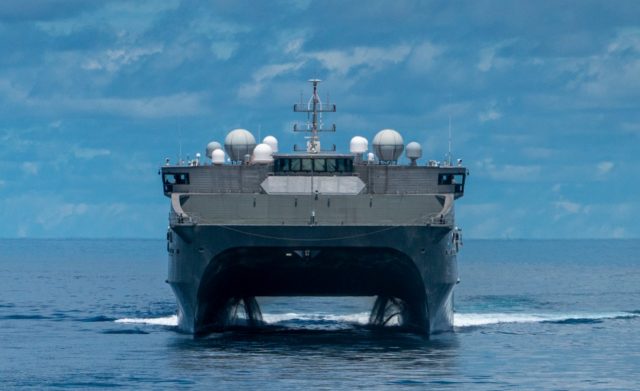The US branch of Australian shipbuilder Austal hosted a keel-laying for the future USNS Cody, Expeditionary Fast Transport Ship (EPF 14), on January 26.
Cody is the first of the Spearhead-class EPF Flight II configuration, which introduces a combined forward resuscitative care capability with a limited intensive care unit and medical ward, while maintaining most of the original requirements of the ship. Flight II EPFs will be able to stabilize postsurgical cases for evacuation without the requirement to first route them through a higher facility.
Other improvements will include habitability modifications, improved small boat handling, as well as the capability to operate the V-22 Osprey tilt-rotor aircraft.
A keel laying is the recognition of the start of a ship’s construction. It is the joining together of a ship’s modular components and the authentication or etching of an honoree’s initials into a ceremonial keel plate.
“The new capabilities of this variant of EPFs fulfills a critical need for the Navy and Marine Corps,” said Tim Roberts, Strategic and Theater Sealift program manager, Program Executive Ships. “Ensuring that the fleet has fast access to the right medical care increases both the safety and readiness of our sailors and marines.”
EPFs are operated by the Military Sealift Command and the USNS Cody is the first ship in naval service named after Cody, Wyoming.
EPF ships provide high speed, shallow draft transportation capabilities to support the intra-theater maneuver of personnel, supplies and equipment for the Navy and Marine Corps. The design of the EPF allows flexibility to support the fleet in maintaining a variety of roles, including humanitarian assistance, maritime security, disaster relief and more.
Austal USA is also in construction on the future USNS Point Loma (EPF 15) with production efforts commencing earlier this month.
In addition to introduce the EPF variant with improved medical capabilities, the navy is also funding work to integrate and demonstrate autonomous capability for one of the Spearhead-class expeditionary fast transport (EPF) ships currently being built.
Also referred to as the Spearhead-class, the EPF ships have been purchased gradually by the navy since 2008, and have had few problems entering service. One of the major issues identified by government testers was the ships’ inability to transport goods at the design speed and capacity. The ships were initially supposed to be capable of carrying 1.2 million pounds of cargo for 1,200 nautical miles at 35 knots, or about 40 miles per hour. However, a 2018 report from the Defense Department Inspector General revealed that the ships could transport the 1.2 million pounds of cargo for 769 nautical miles, and that at a slower speed. Responding to the report, the navy said it was already working on addressing the issues.



























